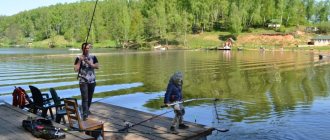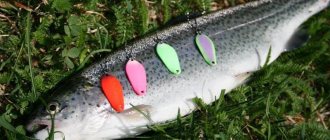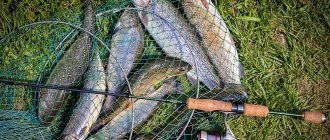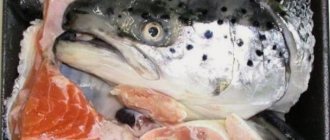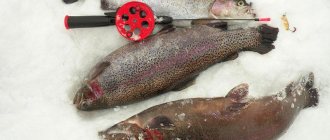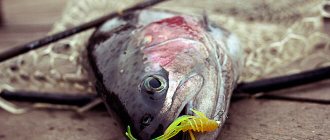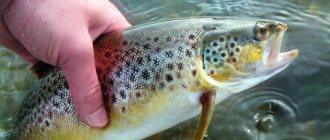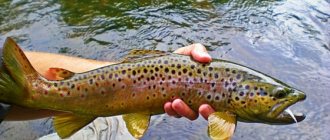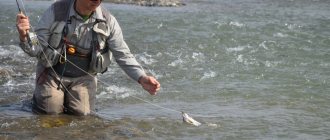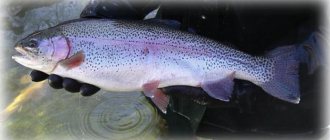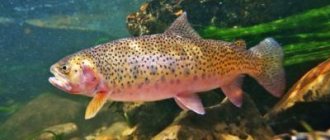Fishing for trout with a fishing rod is popularized in the fishing community thanks to the many paid reservoirs, the owners of which offer comfortable fishing for this interesting fish with their habits and struggle when catching a predator. In the natural habitat of a fish, catching it with a float rig will be problematic, due to the special caution of the trophy, which stays at long distances and, in any suspicious situations, leaves the hunting area, going to shelters. On paid reservoirs, the concentration of predators is much higher, and they are less timid, which makes it possible to fish at short and medium distances with conventional float rods.
We will talk about fishing techniques for most types of float rigs in continuation of our article, revealing the main secrets of assembling this type of gear, identifying promising baits and places for trout fishing, as well as methods for animating rigs.
Rod selection
In the vast majority of cases, trout fishing with a float rod is carried out from the shore at short and medium distances. You can cover such hunting conditions with the help of classic fly rods and Bolognese rods, as well as match gear equipped with float rigs. The style of trout fishing is quite dynamic and one of the general requirements, regardless of the type of fishing rod, is its light weight. Therefore, for such fishing trips, lightweight composite or carbon-fiber rods are chosen, which ensure the reliability of playing actively resisting fish weighing up to three kilograms, but at the same time have a low total weight that does not load the angler’s hands during frequent casting of the equipment.
Fly fishing rod
Fishing for trout with a fly float rod is carried out especially at short distances, so for hunting they select gear from four to seven meters in length. The whip package includes only a fishing line equipped with a mounting, which is attached to the quivertip of the fishing rod thanks to a connector. There is no need to equip the gear with a reel or reel for this style of fishing, since the rigs on trout fishing change quite rarely, and the effectiveness of fishing is largely ensured only by selecting a certain type of bait. Thus, for cramped conditions caused by fishing under the canopy of trees, fishing rods 4-5 meters long are used, and in open areas it is more convenient to fish with a 6-7 meter whip.
Bolognese fishing rod
The lapdog is a more versatile type of fishing rod, which can be used conveniently for fishing both in currents and in still waters, fishing short and medium distances. Trout fishing with a float rig is carried out with lapdogs 5-8 meters long, the form of which is equipped with guide rings and a reel, which in turn can be inertial or a more convenient and practical inertialess version of the mechanism. Bolognese tackle, depending on its length, ensures the supply of relatively light float rigs over average distances of a couple of tens of meters, and also makes it possible to carry out controlled movements of bait downstream using the so-called free rafting method, which brings good results for catching wary predators.
Match fishing rod
A match fishing rod is indispensable when fishing in stagnant lakes and weakly flowing reservoirs, where fish stay at long distances from the coastlines. For trout fishing, they choose plug fishing rods 3-5 meters long, equipped with large guide rings and a spinning reel that is small in size and weight. Match float tackle for trout with light rigs covers average hunting distances of 15-20 meters.
Heavy equipment with floats over ten grams of this kind of fishing rod can be cast over a long distance of 30-40 meters, counting on catching more timid, cautious and, accordingly, larger fish. Some techniques allow you to fish for a match with wiring, but it is still more practical to fish in stagnant bodies of water, where the animation of the bait is provided by the force of the wind or the actions of the angler.
When to catch trout
Fish activity varies significantly depending on changes in water temperature. And if it is more common for fishermen to expect an increase in biting activity for other types of fish with warming water areas, then in this case it is best to catch trout when the water bodies are not warmed up or begin to cool down. The most favorable period for hunting is considered to be autumn, when the temperature of the reservoir drops significantly, and the fish begin to intensively gain fat for the spawning period and winter.
From the first ten days of October until freeze-up, the most significant surge in bite is observed. Fishing is carried out using float, spinning and bottom gear. Winter is a relatively weak season for fishing. The fish does not feed during the mating season, and after it saves energy by hiding in the recesses of the bottom, only occasionally picking up passing food nearby. But knowing the anchorage points of a school of fish, fish can be successfully caught from the ice and taken for bets. With the appearance of melt water and the disappearance of ice, spring activates the predator for increased feeding and until the water temperature stabilizes at levels above 15 degrees, the fish bite greedily and with equal constancy. In muddy water they fish with spinning rods and float rigs. In summer, fish are caught near cool springs and shady shores of the reservoir. The bite is unstable, improving only when it gets colder.
Important! Characterizing the intensity of the bite according to the daily cycle, it is worth noting that in any period of the year, early morning and evening twilight stand out most from the rest of the time in terms of frequent attacks by the predator.
During the day, the bite is active only in late autumn and on some winter days, with a slight thaw. Cloudy weather with light drizzle is ideal for fishing. The sun always negatively affects the activity of cautious and timid fish.
Trout float rod equipment
Fishing for trout with a float does not differ much in terms of installation from most methods of forming equipment for catching peaceful fish. The assembly algorithm consists of selecting a fishing line on which a float balanced by weights, a leash and a hook are attached. The auxiliary accessories for the trout float mounting kit will require swivels, silicone stoppers and quick-release carabiners.
Important! Since trout are quite timid and suspicious, rough equipment definitely does not bring positive fishing results, often simply scaring away the trophy. All components of the installation must be harmonious with each other in size and not stand out with the brightness of the colors.
If possible, equipment should have as few elements and connecting nodes as possible.
Coil
In Bolognese and match fishing rods, the equipment includes reels. Inertialess ones are more popular for assembling gear. They are easier to manipulate when casting and landing fish, they are unpretentious in maintenance and hold a large amount of fishing line, ensuring even the longest casts without worrying about the supply necessary for these purposes. For both matcha and lapdogs, small-sized mechanisms of 1500-2500 units are selected with only a friction clutch, without unnecessary functions.
For the sake of objectivity, it is worth noting that there is an opinion that claims that it is more comfortable to catch trout with a fishing rod equipped with an inertia rod. There is some truth in this, since these types of reels are much lighter than the meat grinders familiar to most anglers. But perfect mastery of the casting technique and the lack of a thin clutch mechanism are serious obstacles to their widespread use in trout fishing by ordinary, and even more so, novice fishermen.
fishing line
Since hunting is carried out at medium and short distances, catching trout with a float rod is ensured by using monofilament fishing line as the main cord. In addition, the monofilament is transparent and does not arouse suspicion in the fish, and its high stretch coefficient quite successfully helps to cope with the sometimes fierce resistance of the trophy that takes the bait. Flying and Bolognese fishing rods are equipped with a fishing line of 0.20-0.25 mm. For matcha, a cord with a diameter of 0.25-0.30 mm is used. The installation must include leashes made of 0.15-0.18 mm nylon lines or fluorocarbon versions of the element with a breaking load an order of magnitude lower than that of the main cord.
Hooks
When selecting a hook for a float mount, they are guided by the type of bait used in fishing. Often the range of an effective and practical piece of equipment falls within the range of 6-10 accessory numbers. When planning to catch large specimens of predators, the use of larger hooks of numbers 3-5 is justified. If fluid baits, trout pastes or dough are used as bait, then hooks with springs are installed in the rigs, which reliably and for a long time hold the bait in the water and during casting. Otherwise, the hooks should have natural color tones, gray or dark blue, and, of course, a sharp point.
Often, at the beginning of fishing, the fishing technique with two hooks is justified. The method allows you to much faster determine the horizon of active fish and, after reconnaissance, switch to the classic type of equipment with one hook. An additional leash can be made longer or shorter than the main one, as well as equipped with different types of bait and thus find the most promising fishing option, increasing the chances of ultimate success.
Floats
The practice of trout fishing shows that drop-shaped, oval or spherical floats are the most effective for fishing. The lower part of the alarm, submerged in water, is painted in non-garish natural tones, but the float antenna, on the contrary, should clearly stand out with its colors on the surface of the reservoir. Fishing on paid platforms has more comfortable conditions, which is why the mass of floats rarely exceeds 10 grams.
Basically, fishing is carried out using signaling devices in the range of 1.5-4 grams. For matcha, sliding types of floats are used; for bologna and swing, it is more practical to use floats with a blind fastening method. In fishing stores you can find floats specialized for trout fishing, the designs of which, with factory settings, take into account the nuances and characteristics of trout biting.
Fishing for trout on a platform
So, my eldest and I are on a trout platform and we will be fishing today using a special float rig for pellets. Assembling a match rod with a reel. The reel is wound with ASSO Molecular Shield 0.2 line. This is a very durable fishing line with a special fluorocarbon coating, which increases the service life of the fishing line, protecting it from mechanical stress during fishing. We put a special float and surround it with olives, which do not injure the fishing line. Due to its design, the float is very noticeable in any conditions, and the low carrying capacity will not give reason to cautious fish!
Attach the leash. To do this, we use a triple swivel as a connector, which will also serve as an anti-twist, because This kind of fishing involves quite active actions with the reel, and the nozzle will rotate in the water, thereby twisting the rather thin leash. For leashes, I use fluorocarbon from Cralusso, unrolled 40 meters with a diameter of 0.16 and a length of about 50 cm. Why this line? Because trout are predators with very good eyesight, and it is very important that the piece of fishing line in front of the bait is minimally noticeable, and fluorocarbon is absolutely invisible in the water.
Since we will be fishing with pelets, and it is hard and cannot be put on a hook, we will use a special silicone device from the Energo Team company. A very useful, inexpensive thing that allows you to fish with pellets, mixed feed and other hard baits without any serious hair installations. We tear off one segment, insert a hook into the smaller ring, move the silicone to the center of the bend and then insert a nozzle into the larger hole - trout pellet with a diameter of 6-8 mm.
There is no need to cast far, because... trout are active throughout the entire reservoir and there are often cases when they grab the bait of spinning rods right at the water’s edge while reeling in. We set the depth to about a meter, because... After a fresh start, trout are very often active in the upper layers of water. We cast about 7-10 meters. We wait until all the equipment drops to the set depth.
If there is no bite within a minute, we begin to play with the rig using a fishing rod. A small stretch, 30-50 centimeters and wait again, stretch again and this time we alternate it with small twitches that are transmitted to the nozzle. A short pause and... the float dives! Bite! Instant hooking, otherwise the trout will swallow the pellets heavily. The fish is not large, but it simply resists desperately, and that is why we took fishing rods and reels for this fishing. Somersaults, candles, but we have strong tackle and trout in the landing net. We carefully remove it from the hook and send it to the fish tank. The first one is there! Seryozhka independently pulled out the rainbow beauty weighing about a kilogram.
In the same way we catch a couple more trout and the activity of the fish decreases greatly. There are no bites. The fishermen nearby clearly got bored and began moving along the shore of the reservoir in search of active fish. For this case, we have saved one effective remedy, this is bait pellets with a diameter of 2.5 mm. We make a close cast, literally the length of the fishing rod, about five meters, put the fishing rod on the stand and, in small pinches, start throwing ten granules to the float at intervals of 2-3 times a minute. The pellets are small, sink fairly slowly and attract trout very well. Plus, this is a favorite delicacy for this fish, because... iris is grown on this feed. Before we have time to throw the third pinch, a bright float goes under the water. Hooking, fighting, but the fish comes off the shore. This happens when the bite is weak. We continue throwing pellets and catch a couple of trout.
Here the neighbors began to pull out the iris on their gear, so we decided to go back to active fishing and put aside the bag with small pellets. That’s right, the intensity of the bites increased in the evening, and the trout eat with great pleasure.
It is very difficult to break away from such fishing, but... the norm has been overfished, confirmation of the effectiveness of such fishing methods has been received, and the day is coming to an end. The result of the fishing, or rather the correct approach to its organization, was a very good catch, but there were people who came to the reservoir precisely at the moment when the trout was inactive and the dissatisfied ones left with nothing!
Try different rig options and fishing methods, adopt interesting devices from fishing for other types of fish - carp, predator and others, and you will be rewarded with a good catch! See you at the pond!
Krasin Alexey aka STARFISH
Choosing a place for fishing
Under natural conditions, trout sections of the river are considered to be water areas with rapids and rocky rifts, where at the boundaries of the currents the predator waits for food carried by the water flow. In lakes, fish stay in deep-water snags with cold springs that constantly replenish the reservoir with fresh water. When studying the prospects of fishing in a paid area, first of all they choose places with bottom anomalies, where there are differences in depth, mounds and holes, snags, submerged tree trunks and large stones. The predator likes to set up ambushes under tree crowns hanging over the water.
Important! Trout avoids water areas with a heavily silted bottom and dense aquatic vegetation.
In summer, in hot weather, you should look for active fish in shaded areas of the reservoir, where the water does not warm up as intensely as in places open to the sun. In autumn and spring, the predator feeds throughout the day. In summer, fishing in the early morning and before sunset brings the best results.
Where to fish for trout
Under natural conditions, river trout fishing is organized on fast, cold streams with depths of no more than 1-1.5 meters. As a rule, the bottom bases of rivers suitable for fish habitat are hard rocky or pebble areas of different levels. Riffles, rapids, and rapids of a stream with areas of relatively calm water are always feeding grounds for this type of salmon fish. Under natural conditions, individuals rarely stay in places with aquatic vegetation, preferring open areas of water areas, where it is better for them to navigate, looking for food in the form of insects that have fallen into the water stream and small helpless fish drawn into the rapid current of the river.
Fishing for trout on a platform is radically different from the conditions of the natural environment. Artificial ponds are mostly stagnant bodies of water with depths of up to three meters and clayey bottoms, surrounded by various vegetation. The boundaries of the depth difference and the squiggles of individual sections of the pond make these places a stopover for fish and their hunting grounds. Trees hanging over the water, shading the water surface, always attract trout due to colder water and the presence of a significant amount of food objects falling into the water from leaves and branches, becoming easy prey for fish. The walls of the coastal reed thickets do not go unnoticed, where the predator plies in search of small things, combing trajectories that follow the contours of the coastline.
Bait for trout fishing
Trout paste
Trout is omnivorous and its diet includes both animal and plant foods. Consequently, baits for trout fishing with a float rod can be of different options. Among animal baits, fishing is promising for fry of the verkhovka, dung worm, maggot and bunch of bloodworms. Insects such as grasshoppers, flies and caterpillars will not be deprived of the attention of a predator if they are presented during the season of their departure or mass exit to the vicinity of the reservoir. Among inert animal baits, shrimp, crab and crayfish meat are popular.
Anglers consider cheese, canned sweet corn, black bread and boiled pearl barley to be the most successful vegetable baits. Particular attention should be paid to this type of artificial bait such as trout paste. They are produced using a special technology with attractants that actively attract predators to the fishing area by smell. Dumplings are rolled out of plastic paste or worms are molded and the bait is placed on a hook. The pastes are distinguished not only by diverse aromas, but also by aggressive exotic colors, among which intense pink shades are considered working colors in most trout reservoirs.
What is pellets
Pellets are a balanced food supplement containing minerals, amino acids, fats, carbohydrates, and vitamins. This composition has been tested in experimental fisheries. The recommended pellet for trout is fish pellet, which is most used when rearing trout.
Fish are fed in winter and summer using all known fishing methods:
- Using a feeder;
- When fishing with a float rod;
- In winter conditions (from ice).
Pellets are used in different ways. When fishing with a float rod, some use point bait, throwing it towards the float. Others regularly feed trout in a permanent place. The most effective feeding is when fishing on a feeder with a feeder, provided that it is selected for standing water or for a river. Another method - the use of a spinning rod is not considered here; its technology does not provide for the use of the specified fertilizing.
Article on the topic: Fishing for trout with paste
How to catch trout with a float rod
A special feature of fishing for the predator we are considering is the constant animation of the bait. The fish rarely reacts to a stationary bait.
Important! Trout bait must be constantly in motion.
Often, the natural movements of a live bait or the waves of a reservoir are sufficient for animation, but in calm conditions the angler has to constantly twitch the rig, attracting active trout to the inert bait. During the current, the bait is floated along the stream, holding the rod in promising places. Active fish can take the bait during its dive, immediately when casting. The predator's bite is sharp. The predator does not try the bait, but tries to immediately swallow the object it likes.
When bitten, the float sinks to the bottom or quickly moves to the side. The fisherman must respond to such signals by immediately hooking and forcing the landing of aggressively resisting fish. Near the shore, the trophy is taken into a landing net with a long handle, since the fish brought to the shore increases the pressure and often with the last jerk breaks off the thin leashes, depriving the fisherman of well-deserved success.
Best Scents for Trout Fishing
For a successful catch, it is recommended to purchase pellets with fish flavors. This is especially important in artificial (paid) reservoirs, since paid reservoirs breed trout brought from fish farms. On farms, fish pellets are used as the main additive. Therefore, it is more familiar and attractive.
However, as practice shows, it would be useful to have a set of baits with other smells: caviar, shrimp, cheese and garlic. After all, trout are often unpredictable.
Usually in cold winters, when there is a lack of food in the reservoir, any scent is triggered. When fishing from ice, food should be sprinkled a little, in small portions, but constantly, so that the movement of the falling granules attracts fish.
